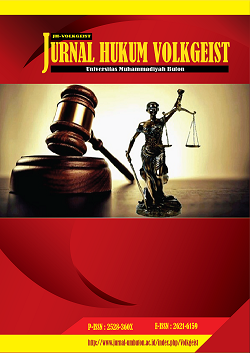The Legal Annalysis of Married Dispensation in The Perspective of Law Number 35 of 2014 Concerning Childhood Protection
DOI:
https://doi.org/10.35326/volkgeist.v5i2.804Keywords:
Dispensation, Marriage, Protection, ChildrenAbstract
The research method used in this research is Normative Empirical research, Empirical Normative research type. The purpose of this research is to know the determination of the marriage dispensation seen from the child protection law and to know the judges' considerations in determining the marriage dispensation what is seen from the child protection law The results of this study indicate that the determination of the dispensation of marriage, seen from the Child Protection Law, can be seen from two things, namely, first, the application for dispensation is in accordance with recommendations and benefits for children in applying for dispensation so that judges in deciding applications always pay attention to benefits. Second is the Factor Causing Marriage Dispensation Which, when viewed from the Child Protection Law, is the factor of children who really want to get married due to sexual misconduct and pregnancy outside of marriage and the factor of concern about religious law where religion is a reference for enjoying even underage children.
Downloads
Downloads
Submitted
Accepted
Published
Issue
Section
License
- Author retains the copyright and grants Jurnal Hukum Volkgeist the right of first publication of the work simultaneously licensed under the Creative Commons Attribution-ShareAlike 4.0 License that allows others to share the work with an acknowledgment of the work's authorship and initial publication in this journal
- The author is able to enter into separate, additional contractual arrangements for the non-exclusive distribution of the journal's published version of the work (e.g., post it to an institutional repository or publish it in a book) with the acknowledgment of its initial publication in this journal.
- The author is permitted and encouraged to post his/her work online (e.g., in institutional repositories or on their website) prior to and during the submission process, as it can lead to productive exchanges, as well as earlier and greater citation of the published work (See The Effect of Open Access).









.png)































